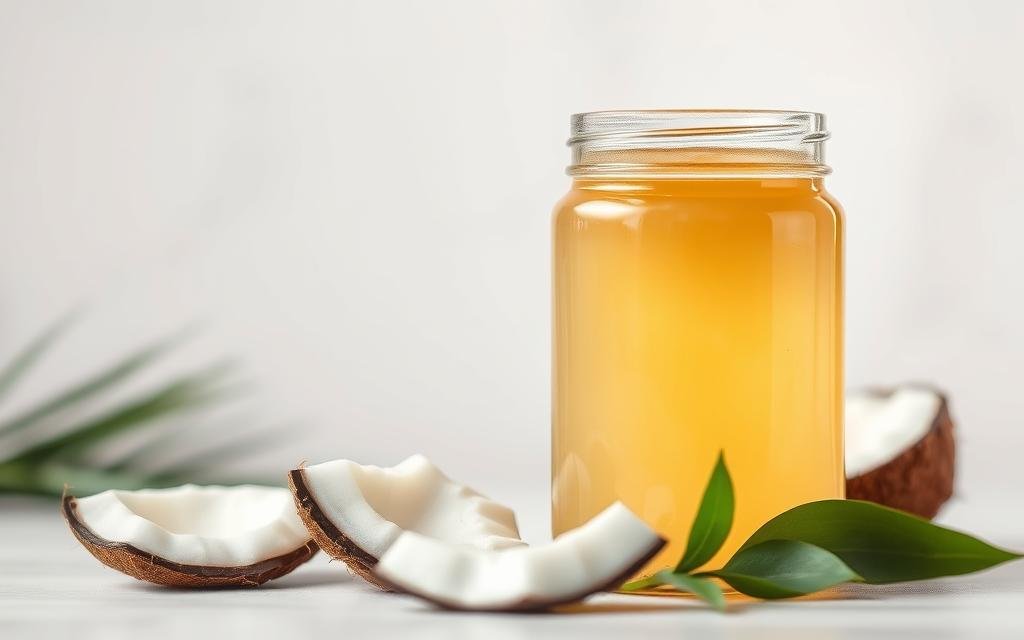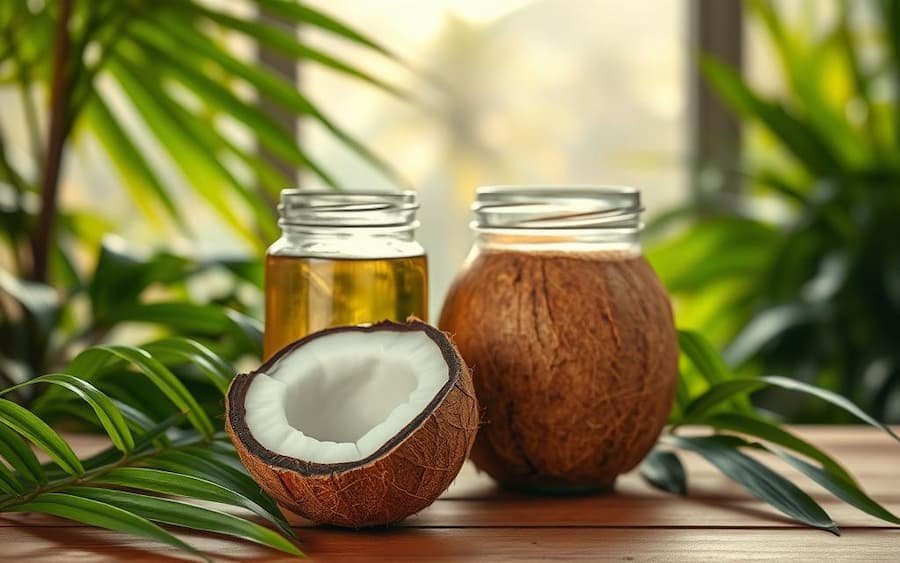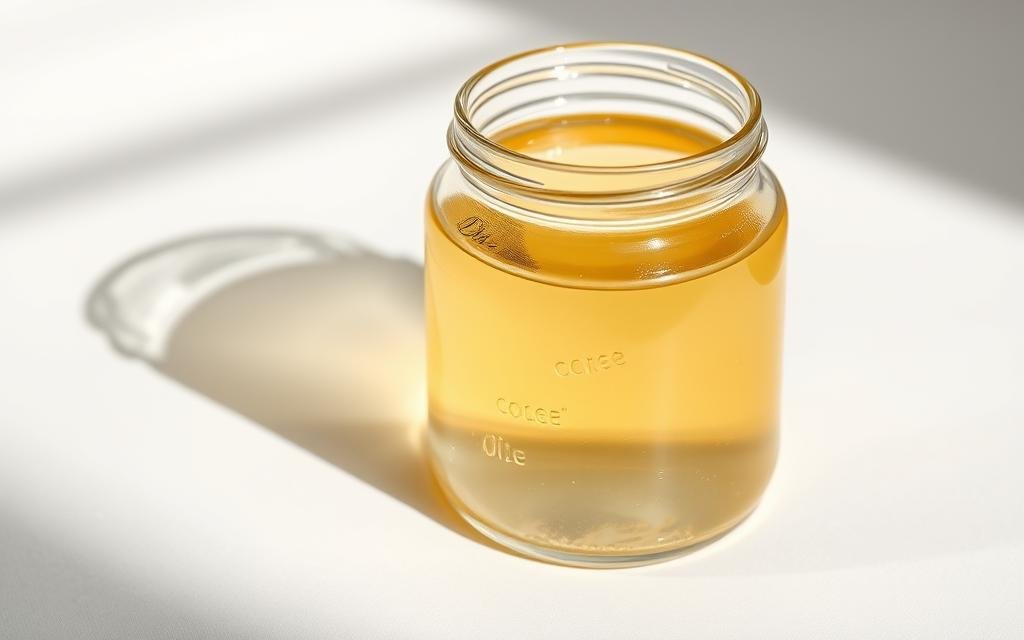Cold Pressed Coconut Oil Supercharges Health & Energy
They remember the first spoon of cold pressed coconut oil. It was warmed between their fingers. The faint aroma of fresh coconut rose like a familiar kitchen story.
In many Indian homes, this scent means care. It means hair oiled before school, a crackling tadka, or a gentle remedy when the season changes. Today, that same tradition meets science, and the promise feels both comforting and new.
This guide explores cold pressed coconut oil benefits with clear, practical insight. It covers how virgin coconut oil differs from refined, why organic coconut oil sourcing matters, and where it truly shines—in energy, hair, skin, and daily cooking. It also speaks honestly about limits: high calories, saturated fat, and cholesterol concerns that the American Heart Association flags for smart use.
Readers will see how MCTs, like lauric acid, can fuel quick energy. They support oral care and help the skin barrier. But, learning when moderation is wise is also important.
For those curious about cold pressed coconut oil for weight loss naturally, the goal here is balance. Evidence, tradition, and daily choices that fit Indian kitchens and routines are what we aim for.

Key Takeaways
- Cold pressed coconut oil offers tradition and science in one jar, with clear benefits and limits.
- MCT-rich profiles may support quick energy and ketone production, but portion control matters.
- Virgin coconut oil retains aroma and antioxidants; organic coconut oil prioritizes cleaner sourcing.
- Hair and skin may benefit from strand penetration and barrier support with simple home use.
- Oral care practices like oil pulling can reduce plaque bacteria when used alongside brushing.
- High saturated fat means mindful use, specially for those managing LDL cholesterol.
What Is Cold-Pressed, Virgin, and Organic Coconut Oil?
In Indian kitchens and beauty routines, cold pressed coconut oil is popular. It’s next to virgin and organic coconut oil. Each term shows how the oil is made and why it tastes and smells different. Knowing these labels helps us use cold pressed coconut oil wisely and buy it with confidence.
Cold pressed means oil is squeezed from fresh coconut meat at low temperatures. This method keeps the oil’s clean coconut taste and minimizes processing. It’s great for cooking, skincare, and hair care.
How cold pressing preserves antioxidants and flavor
The cool press keeps antioxidants stable. Studies show it has tocopherols, tocotrienols, and more. This is why cold pressed coconut oil smells like fresh coconut and tastes great in chutneys and laddoos.
It’s also good for hair and skin. A little bit can be used as a hair mask or body oil. This keeps the natural scent.
Virgin vs. refined: processing, aroma, and purity
Virgin coconut oil is made from fresh coconut without high heat. It has a strong aroma and is good for baking and curries. Refined oil, made from dried copra, is better for stir-fries and roasting.
Virgin oil keeps more nutrients because it’s processed less. Refined oil is better at high heat but loses some nutrients. Knowing this helps choose the right oil for different dishes.
Organic sourcing and why it matters
Organic coconut oil means coconuts were grown without harmful chemicals. It’s better for the soil and can taste cleaner. Organic and virgin oils don’t change the fat content but might keep more antioxidants.
In India, looking for organic labels is important. It shows the oil is made from clean coconuts. People who want the best taste often choose organic or cold pressed oil. Buying cold pressed oil is also good for adding a natural coconut flavor to dishes.
Cold Pressed Coconut Oil
Cold pressed coconut oil is made without high heat. This keeps its MCTs and antioxidants safe. It gets firm in cool weather and melts when it’s warm.
People love its gentle smell and clean taste. They use it in cooking and for their skin and hair.
The oil’s MCTs give quick energy. But, it’s also full of saturated fat. So, it’s important to use it in small amounts.
Many families use it with other oils. This helps balance flavors and nutrients.
For skin, cold pressed coconut oil locks in moisture. It helps dry areas feel better. Studies show it can make atopic skin less itchy.
For hair, it goes deep into the shaft. This reduces breakage and makes hair more flexible. Warm a bit in your hands and apply from mid-lengths to ends before washing.
In oral care, some use it for oil pulling. This can help reduce plaque and bacteria. But, always brush with fluoride toothpaste and floss every day.
Tip: Keep the jar sealed and away from sunlight. This keeps the oil fresh and smelling good. Look for brands like Max Care, KLF Nirmal, and Conscious Food in India. They show how they press the oil and where it comes from.
| Aspect | What It Means | Practical Takeaway |
| Extraction | Minimal heat preserves MCTs and antioxidants | Look for “cold pressed” and “virgin” on the label |
| Texture | Solid at room temp, liquid when warmed | Scoop with a clean spoon; melts quickly in hand |
| Energy | MCTs absorbed rapidly for quick fuel | Use small amounts to avoid excess calories |
| Skin | Supports moisture and barrier in dry skin | Apply a thin layer after bathing |
| Hair | Penetrates shaft to reduce breakage | Use as a pre-wash mask 30–60 minutes before |
| Oral Care | Oil pulling may lower plaque bacteria | Add-on to brushing and flossing, not a replacement |
Cold Pressed Coconut Oil Nutrition and MCT Profile
In India, people often choose cold pressed coconut oil for its taste. But there’s more to it. They look into its nutrition, focusing on how fats are processed in the body and the minor compounds it contains.
MCTs, lauric acid (C12), and how they’re metabolized
Cold pressed coconut oil is full of medium-chain triglycerides, about 65% of its fat. Lauric acid C12 makes up half of these MCTs. Unlike long-chain fats, these molecules go straight to the liver.
They are quickly turned into energy. The liver can also make ketones, which cells use when there’s no glucose. This is why athletes and students in Mumbai, Bengaluru, and Chennai use it before long days.
Calories, saturated fat, and micronutrient traces
One tablespoon has about 120 calories and ~13.5 g fat, mostly saturated. It also has small amounts of myristic and palmitic acids, plus some monounsaturated and polyunsaturated fats.
There’s little or no cholesterol, no fiber, and a bit of plant sterols. These facts help people balance its nutrition with their diet and activity.
Antioxidants: tocopherols, tocotrienols, polyphenols
Cold pressing keeps in antioxidants like tocopherols and tocotrienols, part of the vitamin E family. Polyphenols, flavonoids, and phytosterols are also present in small amounts. They may help protect cells.
Research suggests certain MCTs, like lauric acid C12, might help with diabetes complications. While studies continue, many use it for taste and stability in cooking.
| Nutrient/Compound | Per Tbsp (Approx.) | Role in the Body | Notes for India |
| Total Energy | ~120 kcal | Fuel for daily activity | Plan portions in calorie-dense meals |
| Total Fat | ~13.5 g | Energy storage and absorption of fat-soluble nutrients | Common in South and coastal cuisines |
| Saturated Fat | ~90% of fat | Structural and energy roles | Moderation supports balanced diets |
| Medium-Chain Triglycerides | ~65% of fat | Rapid oxidation and possible ketone formation | Useful for quick energy during busy days |
| Lauric Acid (C12) | ~45–50% of MCTs | Energy; studied for metabolic effects | Key driver of stability and aroma |
| Monounsaturated + Polyunsaturated Fats | Traces | Support cell function | Often complemented with mustard or groundnut oil |
| Tocopherols/Tocotrienols | Small amounts | Antioxidant activity | Preserved through cold pressing |
| Polyphenols & Flavonoids | Trace levels | Support cellular defenses | Contribute to taste nuances |
| Plant Sterols | Trace levels | Interact with cholesterol absorption | Part of cold pressed coconut oil nutrition |
Energy and Metabolism: Quick Fuel and Satiety Support
In India’s heat, many turn to cold pressed coconut oil for energy. It’s full of medium-chain fats, loved by runners and busy folks. It’s also used in coffee or over dosa to stay full.
Note: cold pressed coconut oil for weight loss naturally is talked about. But it works best with balanced meals, veggies, and exercise.

MCTs as a rapid energy source compared with LCTs
MCTs in coconut oil go straight to the liver, unlike long-chain fats. This means quicker energy for workouts or long trips. Athletes use MCTs for fast energy, making it a useful cold pressed coconut oil use.
Satiety and ketone production: what studies suggest
MCTs in the liver make ketones. These might help control hunger and fullness signals. Some studies show less hunger with MCTs, which is why it’s used for weight loss.
But, research often focuses on C8 and C10 MCTs. Coconut oil has more C12. This affects how it works in meals.
Weight management caveats and calorie density
Coconut oil is high in calories, so watch your portions. MCT oil might be more filling than coconut oil. Weight loss results vary. Health experts say to limit saturated fats, aiming for 1–2 tablespoons daily.
Make smart swaps: use a spoon in sambar or blend a bit into smoothies. These choices help meet goals while watching calories and diet quality.
Cold Pressed Coconut Oil Benefits for Hair
In India, many see softer hair, less frizz, and fewer split ends. The oil’s lauric acid helps strengthen hair. This makes it great for those with breakage and dull hair.
Fans of minimal routines love it as a pre-wash, leave-in, or weekly mask. It works well with gentle shampoos from Dove and Himalaya. It suits both long and short hair.
Penetration into hair shaft to reduce breakage
Studies show it binds to hair proteins, reaching deeper. This helps reduce breakage during combing. Regular use makes hair more flexible, bending instead of breaking.
Before heat styling, a light coat acts as a shield. It keeps cuticles smooth and adds shine without heaviness.
How to use cold pressed coconut oil for hair and scalp
For a pre-wash, warm a teaspoon and apply to mid-lengths and ends 15 minutes before shampoo. This keeps hair shiny and roots fresh. Use the same method for skin to avoid residue.
As a mask, apply two tablespoons, braid, and leave for hours or overnight. Rinse with mild cleanser and condition if needed. For leave-in, apply a pea-size amount to damp ends to tame flyaways.
Dandruff care and frizz control tips
Gentle oiling can ease a dry scalp and reduce flakes. Mixing lemon juice or aloe vera gel with oil can soothe. It helps keep the scalp calm between washes.
For frizz, a thin layer of oil seals moisture and improves combing. Use fingertips to apply and a wide-tooth comb to smooth. This keeps hair manageable while keeping the scalp comfortable. Use it sparingly to avoid buildup.
Keyword note integrated naturally: cold pressed coconut oil benefits for hair are achieved with small, steady steps. This makes it wearable every day, in any weather.
Cold Pressed Coconut Oil for Skin Barrier and Hydration
In India’s heat, skin can feel dry. Many use cold pressed coconut oil to keep it moist. It works well without any scent.

Moisture retention and barrier support for dry skin
Apply it to damp skin to lock in moisture. A little bit, like 6–8 drops, can help. It’s great for dry elbows, shins, and heels.
- Tip: Warm a pea-size amount between palms and press onto damp areas post-bath.
- Use light layers to avoid over-occlusion in humid weather.
- Pair with a humectant gel underneath for extra hydration.
Makeup removal and soothing irritated spots
It’s good as a first cleanse, removing sunscreen and makeup. It also has antimicrobial properties. This makes it a cost-effective makeup remover.
- Massage a thin film over the face for 30 seconds.
- Follow with a mild cleanser from brands like Cetaphil or Neutrogena.
- Pat dry and apply a light moisturizer if needed.
Acne-prone skin considerations and pore clogging
Be careful with facial use if you have acne. It might clog pores. Test it on your jawline first.
Use it as a body lotion on dry spots. On the face, use gel moisturizers. Cold pressed coconut oil can be part of a daily routine.
Oral Care and Oil Pulling with Virgin Coconut Oil
In India, many people use virgin coconut oil for oil pulling. They take a spoonful and swish it for 10–15 minutes before spitting it out. This is done daily, along with brushing and flossing, to keep their breath fresh and gums clean.
A 2020 study found that oil pulling cuts down on harmful bacteria like Streptococcus mutans better than regular mouthwash. This is because of lauric acid in the oil, which makes mild soap in saliva. This helps remove plaque and reduce gum inflammation without harsh chemicals.
Using cold pressed coconut oil for oral care is practical. People do oil pulling in the morning before eating, then rinse with warm water. They say it helps reduce morning breath and makes their teeth feel smoother. This method also fights off Staphylococcus aureus and other harmful organisms.
Even with oil pulling, they brush with fluoride toothpaste and floss as a dentist advises. Oil pulling is seen as a cost-effective addition, not a replacement. Those with jaw pain can start with five minutes and gradually increase, or use less oil for easier swishing.
Tip: Pick cold pressed coconut oil from reliable Indian brands for a clean smell and consistent texture. Keep it away from heat to keep it fresh and semi-solid in cooler weather.
Brain and Neurological Considerations
In India, families look for ways to boost brain energy. They consider virgin coconut oil and other fats. These fats can turn into ketones in the liver.
Note on evidence: Studies often use MCTs with caprylic and capric acids. Coconut oil has lauric acid. Yet, people are interested in its benefits with medical advice.
MCTs, ketones, and seizure reduction
Ketogenic therapy helps with drug-resistant childhood epilepsy. It changes the brain’s fuel from glucose to ketones. MCTs in virgin coconut oil can increase ketones, helping control seizures.
Cold pressed coconut oil is used in small amounts in dishes like dosa batter. People watch their calorie intake and stay hydrated. They also eat foods rich in minerals.
Alzheimer’s disease: emerging but limited evidence
The aging brain may not use glucose as well. Ketones can be an alternative fuel. Families add small amounts of virgin coconut oil to help.
But, trials are small and methods vary. People talk to neurologists before making changes. This is because of the difference between purified MCT oils and kitchen oils.
How modified ketogenic approaches use MCTs
Adults might choose a modified ketogenic diet. It includes more MCTs and a bit more carbohydrate. This makes it easier to eat Indian foods like idli and sambar.
Dietitians might mix virgin coconut oil with other oils. This adds flavor and texture. Cold pressed coconut oil is used in curries and soups for extra taste.
| Aspect | Purified MCT Oils (C8/C10‑rich) | Virgin Coconut Oil | Practical Note for India |
| Primary goal | Rapid ketone rise and predictable dosing | Culinary use with broader fatty acid mix | Use MCTs for targeted therapy; use coconut oil for daily cooking |
| Onset of ketones | Faster due to C8/C10 profile | Moderate; lauric acid converts more slowly | Time intake around meals and activity |
| Flavor and aroma | Neutral, minimal aroma | Mild coconut note | Pairs well with curries, stir‑fries, and chutneys |
| Common cold pressed coconut oil uses | Measured shots in clinical plans | Cooking fat, finishing oil, small spoonfuls | Monitor total calories and tolerance |
| Perceived cold pressed coconut oil benefits | Tighter control over ketosis | Accessible, familiar, shelf‑stable | Rotate with regional oils to fit taste and cost |
Reminder: Everyone is different. It’s important to work with a doctor when changing diet for brain health.
Coconut Oil for Cooking: Indian Kitchens and Smoke Points
In Indian kitchens, choosing coconut oil is all about smell, heat, and health. In coastal areas, the taste is as important as the cooking skill. People also want to know how to use cold pressed coconut oil without losing its nutrients or flavor.
When to choose refined vs. virgin for cooking
Virgin coconut oil has a smoke point near 350°F. It’s good for low to medium heat and adds a nutty, sweet scent to dishes. It’s perfect for gentle sautéing, tempering spices, and slow baking.
Refined coconut oil, on the other hand, can go up to 400–450°F. It tastes neutral and is great for stir-fries, high-heat sautéing, searing paneer, and oven roasting. This advice helps pick the right oil for the right cooking task.
Best dishes: curries, baking, and regional tastes
South Indian fish curry, Kerala vegetable thoran, and Goan prawn balchão are all enhanced by cold pressed coconut oil. Its scent makes coconut milk gravies and desserts like payasam or coconut macaroons even better.
For crispy dosas or kadai-style sabzi, refined oil is often preferred for its steady heat. Bakers can try cold pressed coconut oil in brownies or granola by replacing butter, keeping the fat content the same.
Comparisons with olive, mustard, groundnut, and avocado oils
Extra-virgin olive oil has more monounsaturated fat and a strong taste for salad dressings and low-heat sautés. Mustard oil adds a pungent flavor to Bengali and Punjabi dishes. Groundnut oil is mild and nutty, perfect for deep-frying.
Avocado oil has a high smoke point and a clean taste for grilling and roasting. Coconut oil is high in saturated fat, so many kitchens use different oils. Olive oil for dressings, groundnut for frying, and cold pressed coconut oil for dishes where coconut is key.
| Oil | Typical Smoke Point | Flavor Profile | Best Uses in Indian Kitchens | Notes on Fat Type |
| Cold pressed coconut oil (Virgin) | ~350°F (177°C) | Coconut aroma, mildly sweet | South Indian curries, tempering at low heat, baking sweets | High saturated fat; aligns with cold pressed coconut oil uses at moderate heat |
| Refined coconut oil | ~400–450°F (204–232°C) | Neutral | Stir-fries, roasting, high-heat sauté | High saturated fat; choose for higher-heat tasks |
| Extra-virgin olive oil | ~375–410°F (190–210°C) | Fruity, peppery | Dressings, light sauté, Mediterranean-Indian fusions | Rich in monounsaturated fat |
| Mustard oil | ~480°F (249°C) | Pungent, sharp | Bengali jhal, Punjabi pickles, robust tadka | High in monounsaturated and polyunsaturated fats |
| Groundnut (peanut) oil | ~440–450°F (227–232°C) | Mild, nutty | Deep-frying pakoras, stir-fries, chaat components | Higher unsaturated fat |
| Avocado oil | ~500°F (260°C) | Clean, buttery | Grilling, roasting, high-heat tadka | Very high monounsaturated fat |
Quick tip: Match the pan’s temperature to the oil. Using cold pressed coconut oil at the right heat keeps flavors bright and reduces smoke.
Heart Health and Safety: What Indians Should Know
For families balancing taste, tradition, and wellness, heart health matters. Cold pressed coconut oil is loved in coastal kitchens but is high in saturated fat. It has no cholesterol but can raise LDL levels.
A 2020 review showed coconut oil raises LDL more than unsaturated oils but less than butter. HDL might go up, but the American Heart Association warns it’s not enough to lower risk.
In India, where heart disease is increasing, moderation is key. Families can enjoy cold pressed coconut oil’s flavor and texture in small amounts. Using oils like mustard, groundnut, rice bran, or olive helps balance fats.
Choosing organic coconut oil supports cleaner sources and may lower pesticide intake. This fits well with a heart-healthy lifestyle.
Practical tip: use cold pressed coconut oil as a flavor enhancer, not the main fat. Pair it with fiber-rich foods, pulses, and veggies. Keep saturated fats under 10% of daily calories.
For those who love cold pressed coconut oil in chutneys or tadka, use small amounts. Opt for organic oil and check lipid levels regularly.
Cooking choices are important too. Use unsaturated oils for sautéing often, and save cold pressed coconut oil for special dishes. Those with high LDL, diabetes, or a family history of heart disease should talk to a doctor or dietitian.
Eating whole grains, spices like turmeric, and rotating fats supports heart health. This keeps regional flavors alive while being mindful of heart safety.
Checking labels is another step. Look for cold pressed coconut oil with single-origin lots, recent pressing dates, and reputable certifications. Organic oil is cleaner, but portion control is essential.
Regular exercise, sleep, and less sodium complete the plan. This way, the kitchen supports heart health, not hinders it.
Cold Pressed Coconut Oil Uses Beyond the Kitchen
Outside Indian kitchens, cold pressed coconut oil is used in daily routines. People use it to soften skin, tame hair, and for bodywork. Its light scent makes it perfect for beauty kits.
Note on safety: Some use it as a personal lubricant, but it can weaken condoms. Always do a patch test on your arm before using it widely.
Massage, hair masks, and skin treatments
Warm a small amount of oil in your palms for massage. It glides well for long strokes, easing tight muscles. It also softens rough skin on elbows and heels.
For hair masks, apply it from mid-length to ends. Leave it on for 20–30 minutes before shampooing. It reduces frizz and breakage from heat and dust. A thin layer keeps skin moist after showering.
Fractionated MCT oil vs. regular coconut oil
Fractionated MCT oil is liquid, clear, and has little scent. It’s mostly C8 and C10, great for massage and serums. It absorbs quickly and layers well under makeup.
Regular cold pressed coconut oil has lauric acid and firms up in cool rooms. It has a coconut scent and a richer feel, perfect for hair masks. Both are used in beauty, but MCT oil is not for cooking.
Storage, shelf life, and how to spot rancidity
Store cold pressed coconut oil in a cool, dark place with the lid tight. Virgin coconut oil lasts years in the fridge. Fractionated versions stay stable in a pantry.
- Discard if the oil smells sour, waxy, or like old paint.
- Watch for yellowing, haze that does not melt at room temp, or any mold.
- Use dry, clean spoons to prevent moisture and crumbs from getting in.
Trusted Indian brands like KLF Nirmal, Max Care, Coco Soul by Marico, and Organic India offer quality oils. Choose sealed, recent batches for the best results.
How to Use Cold Pressed Coconut Oil Daily and What to Buy
Daily habits matter. To balance taste and cold pressed coconut oil nutrition, they can fit small amounts into meals or care routines. This way, they don’t crowd out unsaturated oils like olive or groundnut. The points below show how to use cold pressed coconut oil with smart timing and simple checks before they buy cold pressed coconut oil.
Smart portions, timing, and culinary swaps
Start with 1 tablespoon per day. Cap at 1–2 tablespoons to respect calorie density—about 120 calories each. This approach aligns intake with cold pressed coconut oil nutrition while keeping saturated fat in check.
Use virgin oil in baking, chutneys, and coconut-forward curries. For high heat, choose refined oil sparingly. Rotate with olive, canola, sunflower, safflower, soybean, peanut, or avocado oils for routine sautéing. A teaspoon before workouts may offer quick energy because MCTs absorb fast; nighttime works well for hair masks and dry-skin spots.
Note that many weight-loss claims come from purified MCT oils rich in C8 and C10. Store-bought coconut oil is mostly C12. Understanding this helps set realistic goals when planning how to use cold pressed coconut oil.
Buy cold pressed coconut oil: labels, purity, and certifications
When they buy cold pressed coconut oil, look for “cold pressed,” “virgin” or “unrefined,” and “certified organic.” Reputable Indian options often list farm origin and pressing method. Check that labels show no hydrogenation, no flavors, and no additives. Packaging should be opaque or UV-safe to protect aroma and quality.
Scan nutrition panels to see serving size, fat profile, and any notes relevant to cold pressed coconut oil nutrition. Clear labeling and third-party seals such as India Organic or USDA Organic support traceability and purity.
Best cold pressed coconut oil: freshness and sourcing checks
They can spot the best cold pressed coconut oil by a clean, natural coconut scent in virgin oil. Look for no sour or soapy notes. Liquefied oil should look clear; solid oil should be white, not yellow. Prefer jars that disclose harvest or press dates and recent batches.
Choose mills with short supply chains in Kerala, Tamil Nadu, or Karnataka. Brands that store oil away from heat and light are best. These steps help align quality with cold pressed coconut oil nutrition while guiding what to buy and how to use cold pressed coconut oil day to day.
Conclusion
Cold pressed coconut oil is great for Indian homes. It gives quick energy and helps fight germs. It also makes skin and hair healthier.
It’s good for your mouth when used for oil pulling. But, it’s best when eaten with healthy foods and exercise.
It’s safe to use in small amounts. But, too much can be bad for your heart. Choose the right type for cooking.
Always check the label for quality. Store it right to keep it fresh. Used wisely, it’s a great addition to a healthy lifestyle.
FAQ
What exactly is cold pressed coconut oil, and how is it different from virgin and organic varieties?
Cold pressed coconut oil is made by extracting fresh coconut meat at low temperatures. This keeps the natural aroma, MCTs, and antioxidants. Virgin coconut oil comes from fresh meat and has a coconut flavor. Organic coconut oil is grown without synthetic pesticides or fertilizers.
How does cold pressing preserve antioxidants and flavor in coconut oil?
Cold pressing avoids high heat. This helps keep tocopherols, tocotrienols, and other compounds. It also keeps the coconut aroma and taste, which can be lost with high heat.
Virgin vs. refined coconut oil: what changes in processing, aroma, and purity?
Virgin oil is made with minimal processing. It keeps its coconut scent and more phytonutrients. Refined oil is made from dried copra and has a higher smoke point. It has less flavor and fewer phytonutrients.
Why does organic sourcing matter for coconut oil?
Organic coconut oil means coconuts were grown without synthetic pesticides or fertilizers. This can mean fewer residues and better environmental practices. It doesn’t lower saturated fat but can influence purity and taste.
What are the main cold pressed coconut oil benefits supported by research?
Benefits include antimicrobial activity and quick energy from MCTs. It improves skin hydration and reduces hair breakage. It also supports oral hygiene and may help with satiety, seizure support, and Alzheimer’s symptoms.
What is the MCT profile of cold pressed coconut oil, and how are MCTs metabolized?
About 65% of coconut oil’s fats are MCTs, with lauric acid making up half. Unlike long-chain fats, MCTs are absorbed directly into the liver. This yields quick energy and ketone bodies.
How many calories and how much saturated fat are in coconut oil?
One tablespoon has about 120 calories and ~13.5 g fat, nearly 90% saturated. It has traces of monounsaturated and polyunsaturated fats and small amounts of plant sterols.
Which antioxidants are present in cold pressed coconut oil?
Virgin, cold pressed oils retain tocopherols, tocotrienols, and other compounds. These contribute to antioxidant activity and may support anti-inflammatory and neuroprotective effects.
Do MCTs in coconut oil really provide quick energy compared with other fats?
Yes. MCTs bypass chylomicron transport and head straight to the liver. This makes them a faster fuel than long-chain triglycerides, a reason athletes sometimes use MCT-rich sources.
Can cold pressed coconut oil help with satiety and weight management?
MCTs can increase ketone production and may influence appetite hormones. This modestly aids satiety. Coconut oil is lauric-acid dominant and not equivalent to C8/C10 MCT oils used in many studies. Evidence for weight loss with coconut oil is mixed; calories add up quickly.
What are the weight loss caveats for coconut oil?
It’s calorie dense and high in saturated fat. This can raise LDL cholesterol. Most adults should limit saturated fat to less than 10% of daily calories, keeping coconut oil to around 1–2 tablespoons within total fat targets, if used.
How does coconut oil reduce hair breakage?
Coconut oil’s fatty acid profile allows it to penetrate the hair shaft. This reduces water-related swelling and protein loss. It improves flexibility and strength, lowering breakage during washing and styling.
How to use cold pressed coconut oil for hair and scalp?
As a pre-wash, smooth a small amount through mid-lengths and ends for 15–30 minutes. For a deeper mask, warm 1–2 tablespoons, apply from scalp to ends, leave for several hours or overnight, then shampoo. Use a tiny amount as a leave-in on damp hair to tame frizz.
Can coconut oil help with dandruff and frizz control?
It can moisturize a dry scalp and may help calm irritation. Some pair it with lemon or aloe in traditional routines, though robust clinical data are limited. For frizz, its occlusive, emollient properties smooth flyaways; use sparingly to avoid greasiness.
What are the benefits of cold pressed coconut oil for skin?
It helps prevent transepidermal water loss, boosting hydration and barrier function. Studies show benefits for dry skin and mild atopic dermatitis. It’s also useful as a gentle makeup remover and for soothing razor burn or irritated spots.
Is coconut oil safe for acne-prone skin?
Coconut oil can be comedogenic for some and may clog pores on the face. Those with acne-prone or oily skin should patch test, use it on the body instead of the face, or choose non-comedogenic oils.
How does oil pulling with virgin coconut oil support oral care?
Swishing 1 tablespoon for 10–15 minutes may reduce Streptococcus mutans and plaque, thanks to lauric acid’s antimicrobial action. It can freshen breath and support gum health but should not replace brushing, flossing, or dental checkups.
Can MCTs in coconut oil help reduce seizures?
Ketogenic therapies use ketones as brain fuel to help control drug-resistant epilepsy. MCTs raise ketones and can support such diets. Note that many protocols use purified C8/C10 MCT oil; coconut oil is not identical but can contribute some MCTs.
What does the evidence say about coconut oil and Alzheimer’s disease?
Early reports suggest ketones may offer alternative energy to the brain, with anecdotal symptom support in mild to moderate cases. Yet, high-quality human trials are limited, and many studies use C8/C10 MCTs instead of lauric-rich coconut oil.
How do modified ketogenic diets use MCTs?
MCT-based ketogenic plans allow slightly higher carbs while maintaining ketosis, because MCTs generate more ketones per calorie. Clinical protocols often rely on purified MCT oils; coconut oil may be an adjunct, not the core fat.
When should someone choose refined vs. virgin coconut oil for cooking?
Choose virgin for baking and low-to-medium heat dishes where coconut flavor shines, like coastal curries or sweets. Choose refined for higher-heat sautéing, stir-frying, and roasting due to its higher smoke point and neutral taste.
What Indian dishes pair best with coconut oil?
Virgin oil complements Kerala and coastal curries, vegetable stir-fries at moderate heat, dosas, chutneys, and baked goods. Refined oil suits higher-heat techniques when a neutral flavor is desired.
How does coconut oil compare with olive, mustard, groundnut, and avocado oils?
Olive and avocado oils are rich in heart-healthy monounsaturated fats; mustard and groundnut offer regional flavor with more unsaturated fats than coconut oil. For cardiovascular health, authorities often recommend prioritizing unsaturated oils and using coconut oil sparingly.
Is coconut oil heart-healthy?
Evidence shows coconut oil can raise LDL cholesterol compared with unsaturated vegetable oils, even if HDL also rises. The American Heart Association advises limiting saturated fat intake and not using coconut oil to improve heart health.
What are common cold pressed coconut oil uses beyond cooking?
It’s popular for hair masks, body moisturizing, massage, and as a makeup remover. Some use it as a sexual lubricant, but avoid with latex condoms, as oils degrade latex. Patch test sensitive skin.
What is fractionated coconut oil, and how is it different from regular coconut oil?
Fractionated oil removes lauric acid and long-chain fats, leaving mainly C8 and C10 MCTs. It’s liquid at room temperature, odorless, and ideal for skincare and massage. Regular coconut oil contains C12, is solid at room temperature, and is used for cooking and hair care.
How should coconut oil be stored, and how can rancidity be spotted?
Keep it in a cool, dark place with a tight lid; refrigeration extends shelf life. Virgin oil can last up to about 3 years refrigerated. Discard if it turns yellow, smells or tastes rancid, develops mold, or shows off-odors.
How much cold pressed coconut oil can be used daily?
In the context of saturated fat limits, many aim for no more than about 1–2 tablespoons per day if it fits within total fat targets. Balance with oils higher in unsaturated fats.
What timing and culinary swaps make sense with coconut oil?
Use virgin oil for flavor-forward, lower-heat dishes and refined oil sparingly for high heat. Swap to olive, canola, sunflower, safflower, soybean, groundnut, or avocado oil for routine cooking to support heart health.
How to buy cold pressed coconut oil—what labels and certifications matter?
Look for “cold pressed,” “virgin” or “unrefined,” and reputable third-party organic certifications (such as USDA Organic or India Organic). Check for non-hydrogenated, additive-free labels and opaque or UV-protective packaging.
What defines the best cold pressed coconut oil for hair and skin?
Freshness, clean coconut aroma (for virgin), clear labeling, and traceability. Choose certified organic, small-batch or recent press dates when available, and avoid products with off-odors or added flavorings. For hair, many prefer virgin oil for its penetrating properties.
Does cold pressed coconut oil help with weight loss naturally?
It can support satiety for some due to MCTs and ketone production, but it is calorie dense and high in saturated fat. Sustainable weight loss depends on overall diet quality, calorie balance, and activity; coconut oil should be used in moderation.
Is cold pressed coconut oil good for cooking every day?
It can be part of a varied oil rotation, but given its saturated fat content, it’s wise to prioritize unsaturated oils for daily cooking and reserve coconut oil for specific dishes or flavor needs.
Can cold pressed coconut oil improve skin barrier issues from frequent hand washing?
Yes. Applying a small amount of virgin coconut oil can help reduce sanitizer-induced dryness by strengthening the skin barrier and reducing water loss, specially when used overnight.
Are there risks or people who should be cautious with coconut oil?
Those with high LDL cholesterol, a family history of heart disease, or on lipid-lowering plans should limit intake. Anyone with acne-prone skin should be cautious with facial use. Always consider total saturated fat across the day.





